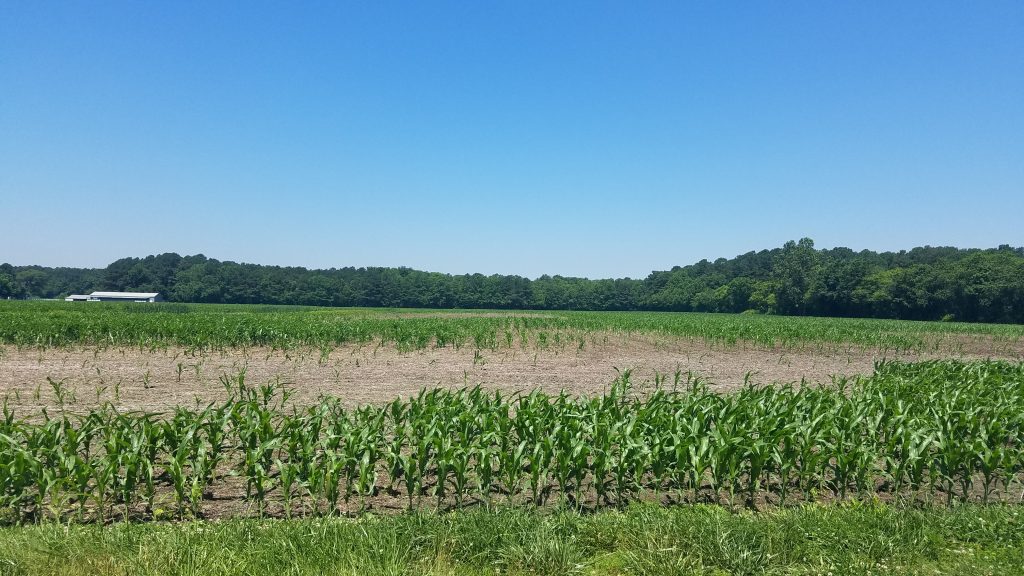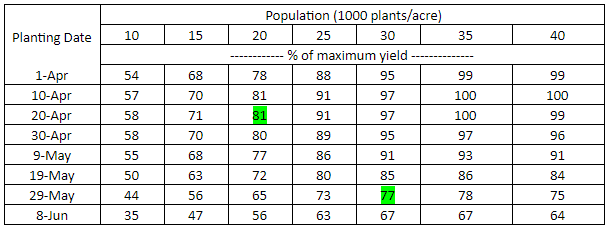
By Bob Kratochvil, Extension Agronomist
University of Maryland, College Park
I wrote this article a couple years ago when we had a very wet May (how quickly we have experienced the same type conditions). What I reported then continues as a guideline for either those who still have corn to plant or those who are considering replanting some of their earlier planted acres. In some cases, you may not have a choice about replanting because the corn has been under water too long and it is going to die. Most agronomists agree that corn can withstand being submerged between 48 and 96 hours, the latter for mid-70’s and lower temperatures and the former for temperatures mid-70’s or higher.
Most agronomists also agree that May 15 is the date at which a yield decline begins if planting occurs after it. And, most also agree that the decline averages approximately 1% for each succeeding day that planting is delayed after May 15. For an anticipated yield of 200 bu/acre for timely planted corn, a delay until May 25 will result in yield decline of approximately 20 – 40 bu/acre depending upon the actual planting date. Hopefully, by the time you read this, you are well on your way toward completion of corn planting or replanting. However, there are some things to consider when planting later.
- Don’t forget about those acres that you planted prior to Mother Nature’s forced vacation. Check those fields to make sure you have an acceptable stand. Remember that it can be costly to replant so accepting a less than optimum stand may be a better option than replanting. The information in Table 1 may help you make a replant decision. There are two steps to using this table. First get an assessment of your stand by taking 10-15 stand counts from across a questionable field. For 30-inch rows, measure 17.5 feet and count the number of plants. Multiply by 1000 to get your population/acre for a count. Add up all your counts and divide by the number of counts you made. Once the stand has been assessed, compare the expected yield from the current stand (find your initial plant date and population in table) with the expected replant yield (anticipated replant date and expected final population). For example, a field planted April 30 with a final stand of 20,000 plants/acre would out-yield a final stand of 30,000 plants/acre planted on May 29 (both are highlighted in green).
Table 1. Planting population and planting date response for corn (Source: Emerson Nafziger, Eric Adee, and Lyle Paul, University of Illinois).

- Once you can get back in the field, resist the temptation to plant before soil conditions are suitable. This will be particularly important for those fields that have heavier soils that need a little longer drying time to attain good planting conditions. By rushing the planting, you may be creating side-wall compaction in the seed furrow. This can become a problem if temperatures quickly get hot and the soil moisture in the seed furrow dries rapidly. The seed that lies at the bottom of these side-wall compacted furrows may suddenly be without moisture and unable to germinate or the young seedling may not be able to penetrate the compacted zone around it to get access to moisture so it can continue to develop. By waiting one or two more days, you will often attain more suitable planting conditions and you will avoid creating a stress situation for your crop. It is easy to say “be patient”; it is harder to comply when you have lots of acres remaining to be planted, but “BE PATIENT”.
- Most hybrids planted in Maryland represent a range of maturity between 105 and 115 days and most producers probably include some representative hybrids across that range as part of their hybrid arsenal. When farmers have delayed planting, the tendency may be to plant the later maturing hybrids first and the earlier maturity hybrids last. Unfortunately, this tactic will result in a narrow pollination window because the difference in maturity among hybrids is determined by the length of time each spends in vegetative growth. Thus, by using the later first and earlier last tactic, you will create a situation that will have most of your corn reaching pollination during the same week to 10 days. What if that period is the same period that we experience hot, dry weather resulting in poor pollination? A better tactic is spread the pollination period out so its duration will last at least two weeks and possibly three. A longer pollination period allows more opportunity for good pollination conditions to occur. So, whether your planting has been delayed or not, I recommend that you plant a mixture of hybrid maturities as you proceed through your planting season to create a wider pollination window.
- The last topic I will address is “when do I decide to change hybrid maturity”? First, I recommend you find out if your seed dealer either has on hand or can easily get some earlier maturing hybrids. Second, I recommend you monitor the 5-10 day forecasts to have some idea of the probability of suitable future planting weather. I know that believing weather forecasts beyond what is going to happen today is often difficult, but those forecasts frequently are reasonably accurate and will provide you with one more decision-making tool. Third, I recommend that you do not opt for earlier maturing hybrids unless your planting is delayed beyond Memorial Day. If you need to plant after this date, I recommend that you choose hybrids with maturity ranging between 95 and 105 days.
